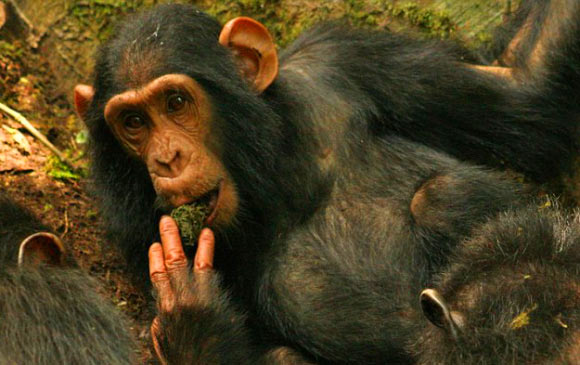For the first time ever, an international team of primatologists has witnessed the spread of a new tool-use behavior in a wild population of chimpanzees.

Young female of the Sonso chimp community using a moss-sponge – a behavior she learned by observing her mother. Image credit: Catherine Hobaiter.
Chimps are widely considered as the most ‘cultural’ of all non-human animals, with 39 socially acquired behaviors, including tool usage, grooming and courtship behaviors.
There is a long-held hypothesis that this behavioral diversity should be interpreted as cultural.
This hypothesis is supported by experimental data from captive groups and a range of observational data. However, for wild groups, there is still no direct experimental evidence for social learning, nor has there been any direct observation of social diffusion of behavioral innovations – until now.
Wild chimpanzees of the famous Sonso community living in Budongo Forest in Uganda have been observed passing new variations of a tool-use technique known as leaf-sponging from individual to individual.
According to the team led by Dr Thibaud Gruber from the University of Neuchatel in Switzerland, Sonso chimps typically manufacture leaf-sponges by folding and chewing leaves in their mouth, subsequently using them in water sources to drink (or collect honey).
But as the scientists filmed members of the community at a novel sponging site, they noticed that some individuals started to use novel variants: moss-sponging (a sponge made of moss or a mixture of leaves and moss) and leaf-sponge re-use (using a sponge left behind on a previous visit).
“Nick, the 29-year-old alpha male chimpanzee, made a moss sponge while being watched by Nambi, a dominant adult female. Over the next six days a further seven individuals made and used moss sponges.”
“Six of these had observed the behavior before adopting it and the seventh was seen to re-use a discarded moss sponge so may have learned about the novel behavior in this way.”
The scientists also recorded a 12-year-old sub-adult male retrieve and use a discarded leaf sponge.
“A further eight individuals adopted the re-use technique, but only four of them observed another individual re-using a sponge first.”
“By using a technique called network-based diffusion analysis the researchers estimated that each time a ‘naïve’ chimpanzee observed moss-sponging, this individual was 15 times more likely to develop the behavior.”
“This striking effect contrasted with the re-use behavior in which social learning played much less of a role.”
Neither moss-sponging nor leaf-sponge re-use had been previously observed in the Sonso community in over 20 years of continuous observation.
“This study tells us that chimpanzee culture changes over time, little by little, by building on previous knowledge found within the community,” said Dr Gruber, who is the senior author of a paper on the findings in the journal PLoS Biology.
“Our results provide strong evidence for social transmission along the chimpanzees’ social network, demonstrating that wild chimpanzees learn novel tool-use from each other and support the claim that some of the observed behavioral diversity in wild chimpanzees should be interpreted as cultural,” said co-author Dr William Hoppitt of Anglia Ruskin University.
_____
Hobaiter C et al. 2014. Social Network Analysis Shows Direct Evidence for Social Transmission of Tool Use in Wild Chimpanzees. PLoS Biol 12 (9): e1001960; doi: 10.1371/journal.pbio.1001960







